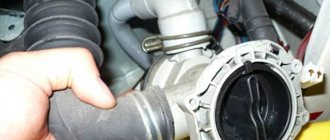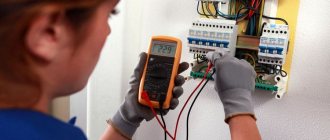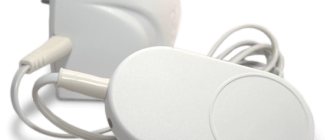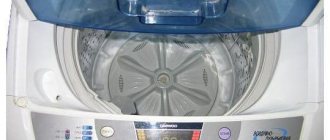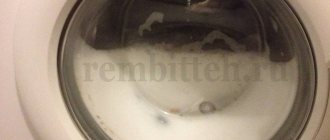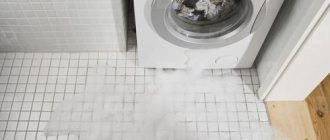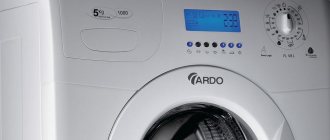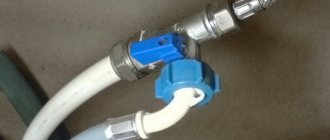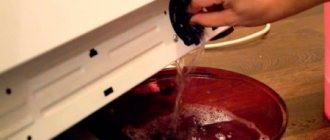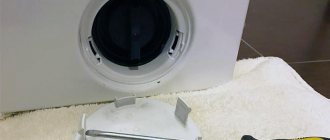A household appliance that has firmly occupied its niche in the modern person’s home is the washing machine.
Among the wide range of manufacturers, Samsung equipment is especially popular, characterized by high quality, functionality, and long service life.
Despite numerous positive characteristics, the consumer may encounter a situation where the Samsung washing machine does not turn on.
A detailed study of why the washing machine does not respond to startup and what to do in this case will help you quickly solve the problem.
Possible causes of malfunction
A malfunction of a Samsung washing machine can be caused by numerous reasons.
The simplest thing that can explain the lack of response to pressing the “start” button is that the device is simply not plugged into the outlet.
They also consider a number of factors that can also affect the performance of a household appliance:
- lack of water,
- incorrect connection,
- failure of system components of the washing machine.
Before turning to professional experts for help, you should conduct a detailed diagnosis yourself. If you follow a certain sequence of actions, you can quickly fix the problem.
What should you check first?
In a situation where the Samsung washing machine does not turn on, diagnostics should begin with the following key points.
Availability of power supply
First of all, check the connection of the washing machine to the power supply. If a device connected to the network does not work, then it is worth checking whether the fuse on the electric meter has blown.
Perhaps the power supply circuit breaker was knocked out due to a burnt-out light bulb , then after turning on the toggle switch, the electricity supply will resume and the washing machine will start working.
If, after plugging the washing machine back into the socket, the safety circuit breaker trips again, then the problem requires a more serious approach to solving and cannot be done without the help of a qualified technician.
Socket performance
Check the presence of electricity in the outlet into which the washing machine is connected. To do this, plug any other household appliance into the outlet. If it works, then the reason should be looked for in the washing machine; if not, then test other outlets in the house.
If the washing machine is connected to the network via an extension cord, it is necessary to check its functionality.
The extension cord is carefully inspected . The plug must be intact, not melted, and the wire must not be pinched.
Hatch closing tightness
The thing is that the Samsung washing machine has a special hatch locking device built into it. If the hatch is not closed tightly (clothes or other foreign objects have gotten into the gap between the doors and the body), then the lock is activated and the washing machine does not turn on.
Possible power surges
There was a sharp surge in voltage, the protection was triggered , as a result of which the washing machine does not work.
If after 10 minutes the device does not work, then a sudden surge in voltage could cause failure of the wiring or electronic control board. Such malfunctions require qualified assistance from a technician.
Quality of connection of the water supply system
There have been cases when the water supply tap was closed for a while and they simply forgot to open it.
Also, the Samsung washing machine does not turn on if the water pressure in the tap is very weak . The pump does not have enough power to draw the required volume of water for washing, and the device turns off.
If, as a result of the initial diagnostics, the Samsung washing machine does not turn on, you will have to stock up on the necessary tools, patience, knowledge and move on to the next stage - disassembling the household appliance and repairing the failed element.
Interference filter
The machine may not start due to a failure of the interference filter. This filter is located in the corner of the top of the machine (immediately under the top cover).
An interference filter (or FPS) is used in automatic washing machines to protect the process and microcircuits from voltage surges. If there is no filter, the processor can burn out from even the slightest voltage surge in the network. In other words, the voltage from the network (220V) first goes to the filter, is normalized, and only then goes to the washing machine circuit board.
So, when the filter is not working properly, it simply does not allow voltage to pass through. That's why the machine won't turn on. You can check the functionality of the filter by ringing its wires at the output and input.
There is such a trick that SM can work even without this filter. Skilled technicians give tips on how to simply close the FPS and the device will work again. However, keep in mind that your machine will no longer be protected and it may not work for long, especially in places with constant voltage drops. It's better to buy a new filter and sleep peacefully. The asking price is from 200 rubles.
More details in the video:
Basic problems and solutions
The external inspection of the washer has been completed, but no problem has been identified. It's time to start disassembling the household appliance.
In order for the work to proceed quickly and efficiently, you must ensure in advance that you have all the necessary tools:
- a set of keys and screwdrivers of different sizes,
- pliers,
- as well as a multimeter (a special device for measuring current and resistance).
Before disassembling the Samsung washing machine, the device must be disconnected from the power supply, water supply and sewerage. To make it easier to approach the washing machine, it is moved away from the wall.
Having prepared for work, you can begin a step-by-step disassembly, diagnostics, and, if necessary, replacement of damaged elements of the Samsung washing machine.
Cord and plug
First of all, check the integrity of the cable at the bend points and the junction with the plug.
To do this, set the multimeter to the “buzzer” mode, apply the probes to the wire cores on both sides . The characteristic squeak of the device indicates the serviceability of the element.
When examining the plug, special attention must be paid to ensure that the plastic body is intact, without cracks or signs of melting. The metal pins in the plug should not move.
If any irregularities are detected, the plug or cable must be replaced.
Hatch door
A prerequisite for starting a Samsung washing machine is that the hatch door is tightly closed (a characteristic click should be heard when closing). If the door does not close tightly, but there is no external mechanical damage, a multimeter will help check the lock’s functionality .
To do this, with the hatch door open, use the tester probes to touch the opposite sides of the lock. If there is no resistance, the number 0 will appear on the device display.
Similar actions are carried out with the hatch door closed. If the resistance indicator has changed, the lock is working; if the indicator is still 0, then the locking element will have to be dismantled and a new one installed.
The work is carried out according to the following algorithm:
- Using a screwdriver and pliers, remove the cuff clamp.
- After unscrewing the fixing bolts from the body, remove the old lock.
- Disconnect the connectors of the old element.
- Connect the connectors to the new lock.
- Fix the new part with bolts to the body.
- Install the cuff and secure it with a clamp.
If the lock is jammed when the door is closed, you need to remove the top panel and, by pressing the latch, open the hatch door.
Power button
Most often, the failure of the power button is caused by wear or oxidation of the contacts . In order to check the functionality of the button, it is tested with a multimeter in the on and off position (the washing machine is disconnected from the power supply).
If the power button is working properly, then in the on position the multimeter will begin to emit a characteristic squeak. If no signals are heard, the button is faulty. If you have a soldering iron, replacing the button will not be difficult.
Algorithm of actions:
- unscrew the fixing bolts and remove the front panel;
- if the cause of the malfunction is oxidation of the contacts, they are simply cleaned; in another situation, the old button is replaced with a new one;
- check the functionality of the new element with a tester.
Before purchasing a new button, it is very important to check that the item number and series match the type and model of the washing machine.
Interference filter
A network noise filter (abbreviated FPS) is an element of the electrical circuit of a washing machine that protects equipment from electromagnetic radiation that occurs during the operation of other household appliances located nearby.
A faulty FPS blocks the operation of the washing machine. In a Samsung washing machine, the FPS is located under the top cover. It looks like a small barrel with five terminals. Three outputs for input (phase, zero, ground) and two for output (phase and zero).
The filter is tested after the element is removed from the washer lid. The FPS is checked with a multimeter (the tester is set to “voltage” mode). Lack of voltage at the outputs indicates a breakdown of the element.
Replacing a surge protector is easy, following a certain algorithm of actions:
- Remove the top cover of the housing.
- The old device is disconnected from the power supply (the bolts are unscrewed, the connectors are disconnected).
- Connect a new element and test it with a multimeter.
The new filter must exactly match the brand of the previously installed part.
Control module
If during the diagnostic process all elements of the electronic circuit turned out to be serviceable, then the reason why the Samsung washing machine does not turn on most likely lies in a faulty control module.
It is possible to determine whether this is so only by ringing each element of the module with a multitester. Before diagnostics, the module (the element is located behind the control panel) must be dismantled.
Repairing or replacing a module requires a highly qualified technician , so without certain skills and knowledge you should not start solving this problem.
Main causes and solutions to problems
Depending on the model, country of origin, modification, generation and a number of operating conditions, the reasons why machines do not turn on can vary significantly. But there are also typical malfunctions, the reasons for their occurrence and ways to eliminate them.
Lack of electricity
- The power grid is de-energized. If water gets into the outlet, significant voltage drops, or several electrical appliances are turned on simultaneously, either the machine or the power grid may not be able to cope with the load. This leads to short circuits, broken plugs, and lack of electricity throughout the house. To solve the problem you need to either reduce the load on the network or replace the wiring.
- Broken socket. You can identify the problem using a multimeter, an indicator screwdriver, or any other electrical device. Broken contacts, deformation of the core, loose socket - all these are quite common reasons why the washing machine does not turn on.
Even when connecting the device for the first time, it is important to ensure that all electrical appliances are in full working order, have no damage or deformation, and can cope with the expected loads without any problems.
The network cable is faulty
The washing machine cord is used in a humid environment, often in a bent form, and is subjected to mechanical stress when hit by a door or in contact with furniture. This leads to abrasion of the insulation or internal breaks. You can identify damage to the power cord using a multimeter or a thorough external inspection.
If defects and deformations are detected, it is advisable to replace the wire rather than try to repair it by twisting or wrapping it with electrical tape. The recommendation also applies to extension cords and surge protectors. Any malfunction of an additional electrical device invariably becomes the cause of much more serious breakdowns of the machine itself.
It is better to entrust the repair of washing machines to professionals!!!
We present to you our unique catalog of private craftsmen and service centers —
Select your city and artist in the filter: by rating, reviews, price!
The on/off button is faulty
On some washing machine models, power is supplied directly to the on/off button. Its malfunction causes the device to stop responding to user actions.
The technical condition of the button is checked by calling the multimeter in buzzer mode. You must first turn off the power to the machine. When turning or pressing the power button, you need to monitor the indicators of the multimeter - a sound signal indicates that the breakdown does not lie in this unit, the absence of a signal will indicate that current does not pass through the button, which means it requires replacement.
Problem with the noise filter (FPS)
Most modern washing machines are equipped with interference filters, which are necessary to minimize electromagnetic radiation generated during operation of the device. Despite the reliability and durability of this unit, its operational properties are extremely negatively affected by periodic power surges and electrical short circuits.
Failure of the FPS (interference filter) leads to a break in the electrical circuit and interruption of the current supply, which results in the absence of any response from the machine to the user’s actions. The unit is checked with a multimeter, which rings the “input” (phase, zero, ground) and “output” (phase, zero). In cases where voltage is detected only at the “input” and its absence at the “output”, the interference filter is considered faulty and must be replaced.
Failure of the control module or command device
These are some of the most complex and expensive breakdowns to repair, which necessarily require professional help. In some cases, technicians recommend purchasing a new washing machine rather than restoring the control module or command device.
When making repairs yourself, it is recommended to initially completely eliminate the possibility of other breakdowns, for example, the wiring of the electrical circuit or the hatch locking system, before starting to work with the control modules.
A multimeter will help you examine these nodes; it will test the existing electrical circuits, contacts, and tracks. The most harmless breakdown is considered to be a violation of contacts that can be soldered. If the microprocessor fails, then repairing the washing machine in most cases will be impractical due to its high cost.
Damage to internal wiring
In cases where, when you turn on the machine, all the indicators and buttons light up simultaneously, but the selected mode does not start, the reason must be sought in damaged internal wiring, loose contacts, their partial destruction or rusting. Due to constant humidity, lack of ventilation and drying of the device after washing, the likelihood of corrosion and mechanical deformation of adhesions increases significantly.
To prevent this type of malfunction, you need to leave the drum door and the powder dispenser hatch and gels ajar after completing each wash. This will ensure natural drying of the internal mechanisms and electronic “stuffing” of the device, and will also prevent the appearance of an unpleasant, musty odor.
Broken hatch locking device
If, after starting the wash, the indicators on the display or dashboard light up, but the wash has not started, you need to try to reopen and close the drum door, making sure that the hatch locking device clicks. If there is no desired effect, you need to check the assembly with a multimeter for the presence of voltage. You should start disassembling the unit and completely replacing it in cases where the tester does not detect the presence of voltage.
Calling a Samsung repairman: where to find it, how to avoid falling for scammers?
In a situation where self-diagnosis and repair of a Samsung washing machine did not lead to the desired result, there is only one thing left to do - call a professional technician.
It’s worth finding out in advance how to do this correctly so as not to encounter scammers.
washing machine repairman
The first leading place in the ranking is occupied by an online service for selecting repair specialists.
There are a sufficient number of services, registration on which will help you quickly choose a specialist and apply for repairs. The advantages of this method: accessibility anywhere in the country, round-the-clock access to the necessary information, a large selection of specialists at various levels.The disadvantages include not always truthful reviews, which can affect the final choice.
- The second item in the ranking is newspaper advertisements. This is a fairly popular and familiar search for a master. A phone call allows you to immediately discuss the details of interest, the cost of the work, and also draw up a preliminary portrait of the person who may come to the call. One of the disadvantages of this method is the amount of time spent on calling.
- The third place of honor in the ranking is occupied by the so-called “word of mouth”. It would seem that what could be more reliable is the recommendations of a friend. But you should never forget that the previous client’s opinion is based not only on the results of the master’s work. A person can formulate a review based on personal feelings. So, for example, being in a not very good mood, few people pay attention to the positive qualities of the master, paying attention only to his shortcomings and shortcomings.
- The fourth place is occupied by service centers. The advantage of such organizations is that both the master and the client are always legally protected (a service agreement is drawn up). It is this official document that will become the basis for legal proceedings in the event of unsuccessful repair of the washing machine.
- The last place in the ranking of the most popular ways to find a craftsman is advertisements on a pole. Of course, this method is not relevant for large cities, but for small towns and villages, advertisements on a bus stop pole will help you find a good local washing machine repair professional.
To avoid dealing with scammers, when choosing a specialist, you should pay attention to the following:
- the master, without studying the problem, immediately names the final diagnosis and the amount of future repairs;
- the so-called “specialist” demands advance payment (even partial) for work not yet completed.
The above signs indicate that most likely the master is a fraudster whose services you should refuse.
The final cost of washer repair depends on many factors:
- price of components,
- urgency of order fulfillment,
- complexity of work.
On average, replacing a lock will cost from 1,500 to 2,500 rubles, replacing a drain filter up to 2,500 rubles, replacing a drain pump up to 4,500 rubles, repairing a module up to half the cost of a new unit.
Find out more about repairing Samsung washing machines in this section.
